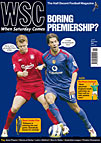 With the launch of the new A-League and a looming World Cup play-off, the game could be on the verge of a major breakthrough – or perhaps not. Mike Ticher reports
With the launch of the new A-League and a looming World Cup play-off, the game could be on the verge of a major breakthrough – or perhaps not. Mike Ticher reports
September is the biggest month for football in Australia, though not usually the round-ball version. So it took a certain amount of chutzpah for the promoters of the new A-League to launch it just as the climax of the Australian rules and rugby league seasons were dominating the sports pages. On the other hand, it had been 17 months since the last gasp of the old National Soccer League, so perhaps there was little to be gained by waiting any longer. After the first few weeks of the eight-team league there is some cause for optimism, but still plenty of doubts.
Having boldly aimed at an average of 10,000 fans per game, the A-League has so far hit a few highs (25,000 in Sydney for the much hyped season-opener against Melbourne), but also some worrying lows (fewer than 6,000 at both home outings for the Central Coast Mariners in Gosford, north of Sydney).
It is a tricky job in presenting the league as entirely different from the NSL, which never escaped the domination of ethnically based clubs, without indulging in wild spending. After Sydney’s Dwight Yorke, the next most glamorous import is probably Brian Deane, recruited by Perth Glory’s inexplicable choice as manager, Steve McMahon. Adelaide United fans could have been forgiven for not noticing the difference when the first A-League goal was headed in by Carl Veart from a cross by Ross Aloisi, both NSL stalwarts with Adelaide City in the early 1990s – except that a crowd of 13,000 was there to see it.
The A-League faces many of the same problems as America’s MLS and has responded similarly. The market is crowded with established and mostly thriving football codes. The league must unite the disparate constituencies, from the vast number of junior players, through migrants and their children who may remain loyal to the ethnic clubs, to more occasional fans attracted by the Premiership and the World Cup. And the league must offer players a credible alternative to playing in Europe. Harry Kewell and Mark Viduka may be out of reach, but the host of Australians toiling away at slightly lower levels shouldn’t be.
The men behind the A-League are modernisers. The billionaire chairman of the Football Federation of Australia, Frank Lowy, whose Westfield shopping centres disfigure the country’s suburbs, was a pioneer of the NSL in the 1970s and an early exponent of club marketing with the old Sydney City (née Hakoah). His chief executive, John O’Neill, is a banker and fresh from the Australian Rugby Football Union, where he oversaw the growth of the Super 12 and delivered the 2003 World Cup. Given this and the commercial failings of the old clubs, the A-League’s strategy was bound to have a corporate feel.
They have kept a tight grip on the clubs through centralised marketing, a punishing salary cap and largely generic playing strips (all “dominated by one proprietary colour”). The league drew the line at allocating the players itself, but otherwise the concept more or less matches the MLS, including woeful marketing-driven names (Melbourne Victory, Queensland Roar) and a fresh-faced audience, lured by what O’Neill insists is “a totally new family-oriented package”. In come Rumble Stix and face-paint; out go any re-enactments of the break-up of Yugoslavia.
The Roar’s chief executive, Lawrence Oudendyk, put it bluntly in response to criticism of the club’s name: “We know the traditionalists – the straight-down-the-line fans who are over 40 – don’t like it, but frankly they are not our target market.”
While that might make WSC readers determined never to darken the Roar’s doors, 20,000 Queenslanders thought differently for the opening game. While the A-League has been pushed into some questionable compromises on the number of clubs (too few), their location (Auckland? Why?) and financing (squads are restricted to 20 players), few would argue there had to be a clean break from what O’Neill called “the fiefdoms, the self-interest, the sectarianism” of the old league. But the federation will need to keep its nerve if crowds drop and franchises falter. Talk if this being “the last roll of the dice” for the game does not inspire much confidence.
The federation has engineered one genuinely new element, by successfully levering Australia into the Asian Confederation. That will ensure regular qualifying matches in Asia for under-age regional and world tournaments, which should help to keep young players in Australia, while the clubs will qualify for the AFC Champions League and AFC Cup. The fans and the long-suffering local players will relish a new stage, even if it is in Uzbekistan or Syria.
Above all, if the new national coach Guus Hiddink can somehow get the Socceroos to Germany in November’s World Cup play-off against a South American team, optimism over the A-League will automatically leap from cautious to wildly uninhibited.
From WSC 225 November 2005. What was happening this month